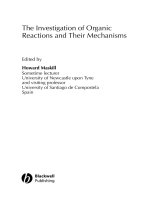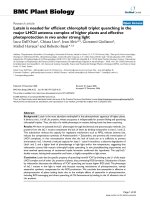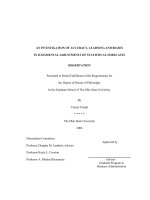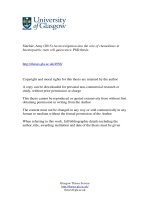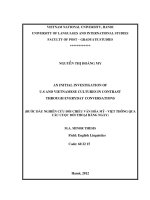Investigation of the antioxidant nature of tropical plants and fruits
Bạn đang xem bản rút gọn của tài liệu. Xem và tải ngay bản đầy đủ của tài liệu tại đây (1.7 MB, 131 trang )
INVESTIGATION OF THE ANTIOXIDANT NATURE
OF TROPICAL PLANTS AND FRUITS
LOW LAN ENG
(B. App Sci. (Hons), NUS)
A THESIS SUBMITTED FOR THE DEGREE OF
MASTER OF SCIENCE
DEPARTMENT OF CHEMISTRY
NATIONAL UNIVERSITY OF SINGAPORE
2008
ACKNOWLEDGEMENTS
This project could not been possible without the funding from the National University
of Singapore and the guidance of my supervisor Dr. Leong Lai Peng. Great thanks to
Dr Hanny Wijaya for bringing the salak and papaya painstakingly from Indonesia to
Singapore for my research project. Much gratitude is extended to the technical staff
Miss Lew Huey Lee and Miss Lee Chooi Lan for their assistance on technical
problems and their kind gestures to make me feel at home in the FST department. I
really appreciate Miss Loo Ying Yan and Miss Lim Hui Min, who spent a lot of
efforts and time on the extraction as part of their UROPS project, which helped move
the project along greatly. Lastly, many thanks to the friends I make during this post
graduate studies, like Agnes Chin, Jorry, Shengbao, Karen, Yi Ling, Mia Isabelle, Xu
Jia, Chen Wei, My Phuc, Li Lu and many others who had given me much help along
the way and make my post graduate study a wonderful experience. Finally, I must
thank my family for their continuous support in whatever decisions I make.
I
TABLE OF CONTENTS
ACKNOWLEDGEMENTS…………………………………………………………...I
TABLE OF CONTENTS……………………………………………………………..II
SUMMARY………………………………………………………………………….VI
LIST OF TABLES…………………………………………………………………VIII
LIST OF FIGURES………………………………………………………………….IX
ABBREVIATIONS………………………………………………………………..XIII
1 INTRODUCTION ..................................................................................................... 1
1.1 Free radicals in biological systems ..................................................................... 1
1.1.1 Types of free radicals and their generation.................................................. 1
1.1.2 Damaging effects of radicals in biological systems..................................... 2
1.2 Antioxidant defense and their reaction mechanism ............................................ 3
1.2.1 Antioxidants and their relationship with health and diseases ...................... 4
1.2.1.1 Water-soluble antioxidants ................................................................... 4
1.2.1.2 Lipid soluble antioxidants..................................................................... 5
1.2.2 Antioxidants from plants.............................................................................. 6
1.2.2.1 Antioxidant properties of plant phenolics............................................. 7
1.2.2.2 Structural requirements for antioxidant activity ................................... 7
1.2.2.3 Classification of flavonoids .................................................................. 8
1.3 Methods of assessing the total antioxidant capacity ......................................... 11
1.3.1 Free radical scavenging methods ............................................................... 11
1.3.1.1 ABTS radical scavenging assay.......................................................... 12
1.3.1.2 DPPH radical scavenging assay.......................................................... 13
1.3.2 Ferric reducing power (FRAP) assay......................................................... 14
1.3.3 Inhibition methods ..................................................................................... 14
1.3.3.1 Total Radical Trapping Parameter (TRAP) method ........................... 15
1.3.3.2 Oxygen Radical Absorbance Capacity (ORAC) assay....................... 15
1.3.4 Total phenolic contents (TPC) ................................................................... 16
1.4 Identification of antioxidants in plants ............................................................. 17
1.4.1 Extraction of antioxidants from plants....................................................... 17
II
1.4.2 Analysis of antioxidants using chromatographic techniques..................... 18
1.5 Structural elucidation techniques...................................................................... 19
2 Experimental Procedures ......................................................................................... 25
2.1 Materials ........................................................................................................... 25
2.2 Sample preparation ........................................................................................... 25
2.3 Methods of determining antioxidant capabilities and total phenolic contents.. 26
2.3.1 ABTS radical scavenging assay................................................................. 26
2.3.2 DPPH Radical Scavenging Activity Assay................................................ 27
2.3.3 Ferric Reducing Antioxidant Power (FRAP) Assay.................................. 27
2.3.4 Determination of Total Phenolic Contents ................................................ 28
2.4 Preparation of the crude extracts of Pereskia bleo, Rhoeo spathacea and
Fructus lycii ............................................................................................................ 28
2.4.1 Double solvent and successive two solvents extraction ............................ 28
2.4.2 Soxhlet and shaker extraction .................................................................... 29
2.5 Preparation of Salak [Salacca zalacca (Gaert.) Voss] (Pondoh) and Papaya
(Carica Papaya) (Bangkok) extracts ...................................................................... 30
2.5.1 Soxhlet and shaker extraction .................................................................... 30
2.6 Statistical analysis............................................................................................. 31
2.7 HPLC analysis of antioxidants.......................................................................... 31
2.7.1 Analysis of antioxidants in Pereskia bleo, Rhoeo spathacea and Fructus
lycii...................................................................................................................... 32
2.7.1.1 Methanol method ................................................................................ 32
2.7.1.2 Acetonitrile method ............................................................................ 32
2.7.1.3 Preparation of sample for spiking test ................................................ 33
2.7.2 Isolation of pure compounds from the water extract of Rhoeo spathacea
using the fraction collector.................................................................................. 33
2.7.3 Analysis of antioxidants in Salak (Salacca zalacca (Gaert.) Voss (Pondoh)
and Papaya (Carica Papaya) (Bangkok) ............................................................ 33
2.8 Purification, isolation and identification of antioxidants of Rhoeo spathacea . 34
2.8.1 Solid Phase extraction................................................................................ 34
2.8.2 ESI-MS and HPLC-DAD-ESI-MS analyses of antioxidants..................... 34
III
2.8.3 NMR spectroscopic analysis of pure isolated compounds ........................ 35
3 Optimization of the extraction parameters of Rhoeo spathacea (Commelinaceae),
Pereskia bleo DC. (Cactaceae) and Fructus Lycii (Lycium barbarum)...................... 36
3.1 Introduction....................................................................................................... 36
3.1.1 Rhoeo spathacea (Commelinaceae)........................................................... 36
3.1.2 Pereskia bleo DC. (Cactaceae) .................................................................. 37
3.1.3 Fructus Lycii (Lycium barbarum).............................................................. 39
3.1.4 Objectives of the study............................................................................... 40
3.2 Optimization of the extraction parameters........................................................ 40
3.2.1 Comparison of the antioxidant activities between soxhlet and shaker
extraction............................................................................................................. 42
3.2.1.1 Optimization of extraction solvent...................................................... 42
3.2.1.2 Optimization of extraction time .......................................................... 45
3.2.2 Antioxidant activities using the double solvent extraction method ........... 47
3.2.2.1 Optimization of extraction solvent...................................................... 47
3.2.2.2 Optimization of extraction time .......................................................... 50
3.2.3 Antioxidant activities using the successive two solvents extraction method
............................................................................................................................. 51
3.2.4 Comparison between the double and successive two solvents extraction
methods ............................................................................................................... 54
3.3 Correlation between the antioxidant assays...................................................... 57
3.4 Conclusions....................................................................................................... 59
References................................................................................................... 60
4 Antioxidants in Pereskia Bleo DC. (Cactaceae), Fructus Lycii (Lycium barbarum)
and Rhoeo Spathacea (Commelinaceae) .................................................................... 63
4.1 Methods of analysis, isolation and characterization of antioxidants ................ 63
4.1.1 Analysis using reversed phase HPLC ........................................................ 63
4.1.2 Purification and isolation of pure compounds ........................................... 64
4.1.3 Characterization tools ................................................................................ 65
4.1.3.1 Mass Spectroscopy.............................................................................. 65
IV
4.1.3.2 Nuclear Magnetic Resonance (NMR)................................................. 65
4.2 HPLC characterization of major antioxidant peaks .......................................... 66
4.2.1 Identification of antioxidant peaks by HPLC with spiking test................. 66
4.2.2 Method development ................................................................................. 67
4.3 Identification of antioxidants using HPLC/MSn ............................................... 71
4.4 Structure confirmation using spectrometric methods ....................................... 77
4.5 Conclusions....................................................................................................... 85
References................................................................................................... 86
5 Study on the antioxidant profile in Salak [Salacca zalacca (Gaert.) Voss]
(Pondoh)and Papaya (Carica papaya) (Bangkok)...................................................... 88
5.1 Introduction....................................................................................................... 88
5.1.1 Salak [Salacca zalacca (Gaert.) Voss] (Pondoh)....................................... 88
5.1.2 Papaya (Carica Papaya) (Bangkok).......................................................... 88
5.1.3 Deep-fat frying vs vacuum frying.............................................................. 89
5.1.4 Objectives of study .................................................................................... 89
5.2 Comparison of the antioxidant activities between fresh and vacuum fried Salak
(Pondoh).................................................................................................................. 90
5.3 Comparison of the antioxidant activities between fresh and vacuum fried
Papaya (Bangkok)................................................................................................... 92
5.4 HPLC analysis of fresh and vacuum fried samples .......................................... 94
5.4.1 Analysis of the antioxidants in salak ......................................................... 95
5.4.1.1 Antioxidants in fresh salak.................................................................. 95
5.4.1.2 Vacuum fried salak ............................................................................. 98
5.4.2 Analysis of the antioxidants in papaya .................................................... 100
5.4.2.1 Antioxidants in fresh papaya ............................................................ 100
5.4.2.2 Antioxidants in vacuum fried papaya ............................................... 102
5.5 Conclusions..................................................................................................... 106
References................................................................................................. 107
6 Overall conclusion and future work....................................................................... 109
Appendices............................................................................................................ 111
V
SUMMARY
The first part of the research project investigated the antioxidant activities of 3 plants:
namely Rhoeo spathacea (Commelinaceae), Pereskia bleo DC. (Cactaceae) and
Fructus lycii (Lycium barbarum). These are some of the medicinal plants which have
potential therapeutic properties but yet little is known about their antioxidant abilities.
Thus, several in vitro methods, such as 2,2’-Azino-bis(3-ethylbenzothiazoline-6sulfonic acid) free radical (ABTS●+) and 1,1-diphenyl-2-picrylhydrazyl (DPPH●)
were employed to understand the free radical scavenging abilities of the plant extract.
The reducing power of the extracts was studied using the ferric reducing antioxidant
power (FRAP) assay while the total phenolic contents (TPC) was also explored using
the Folin Ciocalteau reagent. Good correlations were observed among the four assays.
Different extraction methods were used and compared. The effect of heat during
extraction was studied by comparing the antioxidant activities of plants extracted
using soxhlet and shaker extraction. Two different solvents were used either together
in the double solvent method or one solvent after another in a successive manner
(successive single solvent method). Solvents of different polarities were also studied.
Generally speaking, the soxhlet extraction was the most effective method using water
as the extraction solvent. Rhoeo spathacea gave the highest antioxidant activities,
indicating it as a potential source of phenolic antioxidants.
Analysis of the antioxidants was carried out on the reversed phase high performance
liquid chromatography – diode array detector (RP-HPLC-DAD) by reacting the
extract with free radicals (ABTS●+ and DPPH●). Comparison of the spectrum of the
extract with that of the reaction mixture allowed for easy identification of antioxidant
VI
peaks. The structures of the major antioxidants of Rhoeo spathacea were elucidated
systematically using HPLC-mass spectroscopy (HPLC-MS) and nuclear magnetic
resonance (NMR). The key antioxidant in the water extract of Rhoeo spathacea was
identified as Salvianic acid A.
The last part of the project looked at the effect of vacuum frying on antioxidant
profile of Salak [Salacca zalacca (Gaert.) Voss] (Pondoh) and Papaya [Carica
papaya] (Bangkok) using the HPLC. Making use of the reaction between the free
radicals (ABTS●+ and DPPH●) and the extract, the antioxidants profile of vacuum
fried and fresh fruits could be compared. The effect of different radicals on the
antioxidant profile was also investigated. Variations of results could be observed
between the two fruits.
VII
LIST OF TABLE
Table 3.1 Comparison of each solvent between double solvent extraction method and
successive two solvents method on the ABTS, DPPH, FRAP and TPC assays at
significance level of p < 0.05 for Rhoeo spathacea............................................ 54
Table 3.2 Comparison of each solvent between double solvent extraction method and
successive two solvents method on the ABTS, DPPH, FRAP and TPC assays at
significance level of p < 0.05 for Fructus lycii................................................... 55
Table 3.3 Comparison of each solvent between double solvent extraction method and
successive two solvents method on the ABTS, DPPH, FRAP and TPC assays at
significance level of p < 0.05 for Pereskia bleo ................................................. 56
Table 4.1 LC-MS analysis (characteristics ions and molecular masses) of components
in water extracts from Rhoeo spathacea............................................................. 73
Table 4.2 13C NMR spectral data of compound 1 in acetone-d6 ................................ 80
VIII
TABLE OF FIGURES
Figure 1.1 Structure of (A) tocopherol and (B) tocotrienol .......................................... 5
Figure 1.2 Illustration of antioxidant activity determination expressed as the net area
under the curve (AUC) Figure adapted from Cao et al [18]............................... 16
Figure 2.1 Different extraction methods..................................................................... 30
Figure 3.1 Picture of Rhoeo spathacea ....................................................................... 36
Figure 3.2 Structure of rhoeonin................................................................................. 37
Figure 3.3 Picture of Pereskia bleo............................................................................. 39
Figure 3.4 Antioxidant activities of the 3 plants between soxhlet and shaker extraction
(A) based on their abilities to scavenge ABTS free radicals; (B) Ferric Reducing
Antioxidant Power; (C) Total phenolic content (D) ability to scavenge DPPH
free radicals (n=3, error bars represent standard deviation). .............................. 43
Figure 3.5: Plot of DPPH● scavenging abilities against time of extraction for water
extract (Rhoeo spathacea, A: shaker extraction; B: soxhlet extraction)............. 46
Figure 3.6 Antioxidant activities of the 3 plants using double solvent extraction (A)
based on their abilities to scavenge ABTS free radicals (B) Ferric Reducing
Antioxidant Power; (C) Total phenolic content; (D) ability to scavenge DPPH
free radicals (n=3, error bars represent standard deviation). Three solvent pairs a,
b and c are investigated, where a = MeOH : DCM (1:1), b = EtOH : Hexane (1:1)
and c = Acetone : H2O (7:3). The polar (MeOH and EtOH) fraction is separated
from the non-polar (DCM and hexane) fraction in solvent pairs a and b and
tested for their antioxidant activities................................................................... 48
Figure 3.7: Plot of total phenolic content against extraction time for the 3 sets of
extraction of MeOH using MeOH : DCM (1:1) as extraction solvent (Rhoeo
spathacea) ........................................................................................................... 50
Figure 3.8 Antioxidant activities of the 3 plants using successive two solvents
extraction (A) based on their abilities to scavenge ABTS free radicals; (B) Ferric
Reducing Antioxidant Power; (C) ability to scavenge DPPH free radicals; (D)
Total phenolic content (n=3, error bars represent standard deviation). Extraction
IX
methods using different sequence of solvents are investigated where method a =
extraction using polar solvent followed by non-polar solvent in a successively
manner for 3 cycles; method b = extraction using non-polar solvent followed by
polar solvent in a successively manner for 3 cycles; 1 = MeOH and DCM were
used; 2 = hexane and EtOH were used ............................................................... 52
Figure 3.9 Correlation between antioxidant activities obtained from Ferric Reducing
Antioxidant Power (FRAP) and Total Phenolic Content (TPC) assays. ............ 57
Figure 4.1 Overlaid chromatograms of Pereskia bleo using methanol as eluent,
detection wavelength 280 nm. Solid line: chromatogram of water extract; dashed
line: chromatogram of water extract spiked with DPPH●.................................. 68
Figure 4.2 Overlaid chromatograms of Fructus lycii using acetonitrile as eluent,
wavelength 280 nm. Solid line: chromatogram of water extract; dashed line:
chromatogram of water extract spiked with DPPH●.......................................... 69
Figure 4.3 Overlaid chromatograms of Rhoeo spathacea using methanol as eluent,
wavelength 280 nm. Solid line: chromatogram of water extract; dashed line:
chromatogram of water extract spiked with DPPH●.......................................... 70
Figure 4.4 Structure of Vitexin and Orientin .............................................................. 71
Figure 4.5 LC-MS spectrum of water extract of Rhoeo spathacea using methanol as
eluent................................................................................................................... 73
Figure 4.6 MS spectrum of compound 1 .................................................................... 74
Figure 4.7 Syringic acid.............................................................................................. 75
Figure 4.8 MS spectrum of compound 3 .................................................................... 76
Figure 4.9 UV-Vis spectrum of compound 1 from 190-370nm ................................. 78
Figure 4.10 1H-NMR spectrum in acetone-d6 of compound 1 ................................... 79
Figure 4.11 H-H COSY correlations spectrum of compound 1.................................. 81
Figure 4.12 HMQC C-H correlations of compound 1 ................................................ 82
Figure 4.13 HMBC C-H correlations of compound1 ................................................. 83
Figure 4.14 Structure of compound 1 (Salvianic acid A.) .......................................... 84
Figure 5.1 Antioxidant activities of fresh and vacuum fried salak using either soxhlet
or shaker extraction method based on (A) their abilities to scavenge ABTS free
X
radicals; (B) Ferric Reducing Antioxidant Power; (C) Total phenolic content (n=3,
error bars represent standard deviation).............................................................. 91
Figure 5.2 Antioxidant activities of fresh and vacuum fried papaya using various
extraction conditions based on (A) their abilities to scavenge ABTS free radicals;
(B) Ferric Reducing Antioxidant Power; (C) Total phenolic content (n=3, error
bars represent standard deviation). ..................................................................... 93
Figure 5.3 Overlaid chromatograms of fresh salak, wavelength 320 nm. Solid line:
chromatogram of water extract; dashed line: chromatogram of water extract
spiked with ABTS●+........................................................................................... 95
Figure 5.4 Overlaid chromatograms of fresh salak, wavelength 320 nm. Solid line:
chromatogram of water extract; dashed line: chromatogram of water extract
spiked with DPPH●. ........................................................................................... 96
Figure 5.5 Overlaid chromatograms of vacuum fried salak, wavelength 320 nm. Solid
line: chromatogram of water extract; dashed line: chromatogram of water extract
spiked with ABTS●+........................................................................................... 98
Figure 5.6 Overlaid chromatograms of vacuum fried salak, wavelength 320 nm. Solid
line: chromatogram of water extract; dashed line: chromatogram of water extract
spiked with DPPH●. ........................................................................................... 98
Figure 5.7 Overlaid chromatograms of fresh salak and vacuum fried salak
chromatograms, wavelength 320nm. Solid line: chromatogram of vacuum fried
salak extract in water with antioxidant peaks 1'-4'; dashed line: chromatogram of
fresh salak extract in water with antioxidant peaks 1-5...................................... 99
Figure 5.8 Overlaid chromatograms of fresh papaya, wavelength 280 nm. Solid line:
chromatogram of water extract; dashed line: chromatogram of water extract
spiked with ABTS●+......................................................................................... 100
Figure 5.9 Overlaid chromatograms of fresh papaya, wavelength 280 nm. Solid line:
chromatogram of water extract; dashed line: chromatogram of water extract
spiked with DPPH●. ......................................................................................... 101
Figure 5.10 Overlaid chromatograms of vacuum fried papaya, wavelength 280 nm.
Solid line: chromatogram of water extract; dashed line: chromatogram of water
extract spiked with ABTS●+. ............................................................................ 102
XI
Figure 5.11 Overlaid chromatograms of vacuum fried papaya, wavelength 280 nm.
Solid line: chromatogram of water extract; dashed line: chromatogram of water
extract spiked with DPPH●. ............................................................................. 103
Figure 5.12 Overlaid chromatograms of fresh papaya and vacuum fried papaya
chromatograms, wavelength 280nm. Solid line: chromatogram of vacuum fried
papaya with water; dashed line: chromatogram of fresh papaya with water.
Retention times of peak 1=3.3 min, 2=3.77 min, 3=4.12 min, 1'=3.3 min, 2'=3.65
min, 3' = 4.11 min and 4'=4.55 min. ................................................................. 104
XII
ABBREVIATIONS
AAPH
2,2-azobis-(2-aminopropane) dihydrochloride
ABAP
2,2’-azobis-(2-amidinopropane) dihydrochloride
ABTS
2,2’-azino-bis-(3-ethylbenzothiazoline-6-sulphonic acid)
ANOVA
One-way analysis of variance
BHT
butylated hydroxytoluene
CI
Chemical Ionization
CID
Collision induced dissociation
COSY
Correlation Spectroscopy
DAD
Diode Array detector
DCM
Dichloromethane
DPPH
2,2-diphenyl-1-picrylydrazyl
DW
Dry weight
EI
Electron Ionization
ESI
Electrospray Ionization
FAB
Fast atom bombardment
FM
Fluorescent marker
FRAP
Ferric Reducing Antioxidant Power
GAE
Gallic acid Equivalent
HMBC
Heteronuclear Multiple Bond Correlation
HMQC
Heteronuclear Multiple-Quantum Coherence
MALDI-TOF
Matrix assisted laser diffraction ionization – time of flight
MS
Mass Spectroscopy
NMR
Nuclear magnetic resonance
ORAC
Oxygen Radical Absorbance Capacity
Ppm
parts per million
RI
Refractive index
RNS
Reactive nitrogen species
ROS
Reactive oxygen species
R-PE
R-Phycoerythrin
RP-HPLC
Reversed Phase High Performance Liquid Chromatography
XIII
SPE
Solid phase extraction
TAC
Total antioxidant capacity
TEAC
Trolox equivalent antioxidant capacity
TIC
Total Ion Chromatogram
TMS
Tetramethylsilane
TPC
Total Phenolic Contents
TPTZ
2,4,6-tripyridyl-s-triazine
TRAP
Total Radical Trapping Parameter
TROLOX
6-hydroxyl-2,5,7,8-tetramethyl-2-carboxylic acid
UV
Ultraviolet visible
XIV
CHAPTER 1
INTRODUCTION
1.1 Free radicals in biological systems
1.1.1 Types of free radicals and their generation
Compounds that contain one or more unpaired electrons are commonly coined as free
radicals. Thus, free radicals are usually unstable due to their high energy state. There
are a couple of ways in which free radicals could achieve a full octet which is a more
stable state. One of the ways is via the reaction of the free radical (R•) with another
highly reactive free radical (X•) such that a stable molecule (RX) is formed. This is a
coupling reaction as in Eqn 1.1.
R• + X• → RX
Eq 1.1
The second way is when R• takes part in a self propagation chain reaction as in Eq.
1.2. It will first remove an electron from a stable molecule (Y:), resulting in the
formation of free radical Y•, which is then capable of reacting with another molecule
Z:. Reaction of Z• with another free radical could terminate the chain reaction [1].
R• + Y: → R: + Y•
Eq 1.2
Y• + Z: → Y: + Z•
Some examples of free radicals in our biological systems are the sulphur-centered
radicals, chlorine, carbon-centered ones, transition-metal ions and the reactive
nitrogen species (RNS) which are mainly oxides of nitrogen. Other more important
1
ones are the reactive oxygen species (ROS) which include hydroxyl radical (HO•),
superoxide radical (O2•-), peroxyl radical (RO2•), alkoxyl radical (RO•) and
hydroperoxyl radical (HO2•). Some non-radical forms of ROS include ozone and
hydrogen peroxide.
The ROS are produced by several different mechanisms. Firstly, they could be a
consequence of the interaction of ionizing radiation with biological molecules.
Secondly, they might occur as the byproduct of cellular respiration. The release of
some electrons in the electron transport chain could reduce the oxygen molecules to
the superoxide anion during cellular respiration. Lastly, they could be synthesized by
specific enzymes in phagocytic cells like neutrophils and macrophages (1).
1.1.2 Damaging effects of radicals in biological systems
Metabolism produces by-products such as free radicals (ROS and RNS) that could
lead to oxidative stress, which in turn is a major cause to the damages in the DNA,
proteins and lipids. This damage could also occur as a result of an excess or
deficiency of dietary antioxidants and other essential constituents. Studies had shown
that oxidative stress could be a major contributor to aging and degenerative diseases
such as cancer, cardiovascular disease, cataracts, immune system decline and brain
dysfunction (2).
Lipid peroxidation is probably the most commonly known effect of oxidative stress.
The production of fatty acid hydroperoxides during lipid peroxidation could be
2
detrimental to cells. Protein oxidation could occur when proteins are subjected to
oxidative stress, resulting in a critical loss of sulfhydryl groups. On top of that, the
amino acids might be modified, leading to the formation of carbonyls and other
oxidized moieties. Oxidized proteins are susceptible to proteolysis and the
accumulation of proteins carbonyl groups appears to increase with age. Aging could
result in the losses of physiological and biochemical functions that might eventually
lead to damages in the DNA (3). Cell might behave differently and in the worst case,
cell death might occur. However, cells can normally tolerate mild oxidative stress
where an up-regulation of the antioxidant defence systems will occur (1).
1.2 Antioxidant defence and their reaction mechanism
To counteract the harmful effects of ROS/RNS produced in the body, defence
mechanisms have evolved to scavenge radicals and other reactive species. These
consist of enzymes, which are mostly intracellular, and low-molecular mass
antioxidants, which are located both inside and outside the cell.
The first line of intracellular defences is via enzymes such as the superoxide
dismutase, catalase, peroxidase and ‘thiol-specific antioxidants’. The second way
works via proteins that minimize the availability of pro-oxidants such as iron ions,
copper ions and haem. Examples of such proteins are transferrins and metallothionein.
This category also includes proteins that oxidize ferrous ions, such as caeruloplasmin,
or even proteins that protect biomolecules against damage by other mechanisms. The
last defence mechanism lies in low molecular mass agents that scavenge ROS and
3
RNS. Examples are glutathione, α-tocopherol, bilirubin and uric acid. Some of these
low-molecular-mass antioxidants such as L-ascorbic acid and α-tocopherol, come
from the diet. There is an intimate relationship between nutrition and antioxidant
defense (4). However, the damaging effect of ROS and RNS is not perfectly nullified
by the antioxidant defense systems; some oxidative damage still occurs in healthy
organisms.
1.2.1 Antioxidants and their relationship with health and diseases
There are two major categories of antioxidants: namely the water-soluble and the
lipid-soluble antioxidants.
1.2.1.1 Water-soluble antioxidants
One of the most well known and studied water-soluble antioxidant is the L-ascorbic
acid, which is commonly known as vitamin C. L-ascorbic acid could be easily found
in our diet, especially from the fruits and vegetables.
The biochemical importance of ascorbic acid is related to its reducing potential. The
strong reducing potential makes vitamin C an efficient radical scavenger. L-ascorbic
acid had shown pro-oxidant properties. Theoretically, it could have a damaging prooxidant rather than an antioxidant role if transition metal ions are available. Under
normal circumstances where little transition metal ions are available, the antioxidant
effects of L-ascorbic acid should predominate (2).
4
1.2.1.2 Lipid soluble antioxidants
Lipid soluble antioxidants, which are capable of transferring the radical function from
the lipid into the aqueous phase, appear to be especially effective in preventing lipid
peroxidation.
R1
HO
R2
A
O
R3
R1
HO
R2
B
O
R3
R1 = CH3, R2 = CH3, R3 = CH3
R1 = CH3, R2 = H, R3 = CH3
R1 = H, R2 = CH3, R3 = CH3
R1 = H, R2 = H, R3 = CH3
α-tocopherols or tocotrienols
β-tocopherols or tocotrienols
γ- tocopherols or tocotrienols
δ- tocopherols or tocotrienols
Figure 1.1 Structure of (A) tocopherol and (B) tocotrienol
Vitamin E is a generic form of all tocopherol and tocotrienol derivatives. Tocopherol
has a phytyl side chain, and tocotrienols has three double bonds in the side chains as
5
in Figure 1.1. The α-, β-, γ-, and δ-tocopherols and tocotrienols differ in number of
and position of the methyl groups on the chroman ring. In the human, α-tocopherol is
most abundant, followed by γ -tocopherols. α-tocopherol is the major scavenger of
free radicals during lipid peroxidation. It scavenges peroxyl radical intermediates in
lipid peroxidation and become the less reactive tocopheryl radical. This radical can be
recycled to α-tocopherol by L-ascorbic acid and ubiquinol (3).
1.2.2 Antioxidants from plants
As mentioned before, the damaging effect of free radicals could be alleviated via the
intake of dietary antioxidants. Thus, the search for different sources of antioxidants is
of constant interest and natural sources are more desirable than ever.
Plants produce a wide variety of organic compounds, of which the vast majority are
not directly involved in growth and development. Such compounds are often referred
to as ‘secondary metabolites’. Many secondary metabolites provide resistance against
pathogens and herbivores, as well as reproductive advantages. There is growing
evidence that secondary metabolites have a host of physiological activities related to
protection against various forms of environmental stress (5). One kind of secondary
metabolites is the phenolic compounds which have shown to be potential antioxidants,
anticarcinogens and cardioprotective agents.
6
1.2.2.1 Antioxidant properties of plant phenolics
Plants phenolics are known to exhibit antioxidant properties and are characterized as
aromatic compounds that possess one or more ‘acidic’ phenolic hydroxyl groups.
Phenolic compounds are excellent antioxidants by virtue of the electron donating
activity of the ‘acidic’ phenolic hydroxyl group.
Two properties of phenolic compounds account for their radical scavenging
properties. Firstly, the reduction potentials of phenolics are typically lower than those
of the oxygen radicals such as superoxide, peroxyl, alkoxyl and hydroxyl radicals.
This implies that these species will readily oxidize phenolics to their respective
phenoxyl radicals. Secondly, phenoxyl radicals are generally less reactive than
oxygen radicals, thus preventing further oxidative reactions (5).
1.2.2.2 Structural requirements for antioxidant activity
Flavonoids are polyphenolic compounds found naturally in fruits and vegetables.
They are widely distributed in nature and many claims have been made regarding its
biological activities.
The general structure of flavonoids is as follows. This is the basic “flavan nucleus”,
the foundation structure upon which flavonoids are constructed.
7
3'
4'
8
7
A
B
O
2
5'
C
6'
3
6
5
4
Flavonoids with the ortho-dihydroxy (catechol) structure in the B ring are considered
more active as hydrogen-donating antioxidants than monohydroxy phenolics. This is
due to the fact that an additional hydroxyl group in the ortho position lowers the oneelectron reduction potential of the phenolic group by approximately 300-400mV, thus
increases the stability of the corresponding phenoxyl radical. Other important
structural features for antioxidant activities in flavonoids include the presence of the 2,
3 double bond on the C ring and hydroxyl groups in the 3 and 5 positions on the C
and A rings respectively.
1.2.2.3 Classification of flavonoids
Flavonoids encompass a large group of products that includes chalcones, flavones,
flavonols, catechins, anthocyanins and proanthocyanidins. They range in structure
from relatively simple phenols, such as the salicyclic acid, to complex polymers such
as suberin and lignin.
8
The different classes of flavonoids structures are distinguished by fairly minor
variations based on the basic “flavan nucleus”. There are eight different basic
structures of the different classes as below (5):
Anthocyanidins and anthocyanins:
This is the class of flavonoids that is commonly found in fruits and vegetables as
these are the pigments that give dark red, blue and purple colors to the plants.
O
O
O
OH
anthocyanidin
sugar
anthocyanin
Anthocyanins contain a sugar molecule at position 3. Other positions may also be
glycosylated.
Proanthocyanidins or condensed tannins: This group of antioxidants contains
polymers made from multiple flavanols, which could consist of two to ten or more
subunits. Under acid hydrolysis, the proanthocyanidins will break into cyanidin.
Oligomeric proanthocyanidins are short chain polymers which are water-soluble.
They are mainly responsible for astringency in many fruits such as grape skins,
blueberries and other dark coloured plant parts. Red wine is also well-known for its
exceptionally high level of proanthocyanidins.
9
Flavanols: The most common type of
flavanols is the flavan-3-ol, which has an –
O
OH group attached to the 3 position of the
OH
flavanol
basic flavan skeleton. One of the most
common flavan-3-ol is catechin which could
be found in food such as green tea, cocoa powder, red wine and other herbs.
Epicatechin differs from catechin only in the spatial orientation of its –OH group.
Flavonols: The basic flavonol skeleton has
O
the –OH at position 3 and the =O at position
4. It also differs from the flavanols by
OH
having a double bond between carbons 2 and
3 on the C ring. The most common flavonol,
O
flavonols
quercetin, is found abundantly in many
herbs and foods such as onions.
Flavones:
The
flavones
resemble
the
structure of flavonols, except for its absence
O
of –OH group at the 3 position. Apigenin
and luteolin are commonly found in plants
and vegetables. Isoflavones refer to the
flavones
O
10


